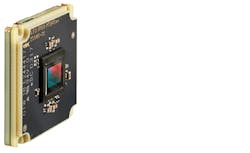Machine vision camera companies expand focus to include embedded vision
As embedded vision system cost, size, and power consumption decrease over time, machine vision and image processing will proliferate into thousands of new applications. Perhaps realizing this, three time-tested machine vision camera companies have expanded their product development and focus into the realm of embedded vision over the past year. Basler (Ahrensburg, Germany; www.baslerweb.com), a company that recently acquired embedded vision consulting and development company mycable Gmbh and launched the Imaginghub online portal for embedded vision, in February introduced a set of cameras based on existing dart cameras that feature the MIPI CSI-2 interface.
Allied Vision 1 product features a proprietary vision processor.
These cameras can be connected to select embedded platforms in the Qualcomm Snapdragon extended life product portfolio on a Linux Open Embedded operating system (Linaro). The first available models are the daA2500-60mm and daA2500-60mc (monochrome and color), which feature the 5 MPixel AR0521 CMOS image sensor from ON Semiconductor, and come equipped with the appropriate driver package for controlling the sensor and image acquisition via the MIPI CSI-2 interface and a flexible flat cable and small connector. “Our primary goal is to bring our machine vision expertise to the embedded marketplace,” said Tim Coggins, Team Leader Module Business – Americas, Basler. “Our development of lean camera module design, along with small but powerful processor architecture is driving down traditional machine vision system costs.”
He continued, “This trend will continue in opening up markets where we were at one time too expensive in offering solutions or to compete. These emerging markets and clients have also needed a level of quality and long-term reliability that they have not been able to achieve. These conditions are creating a breeding ground for innovation and filling a void that exists between traditional machine vision and the consumer electronics marketplace.”
Another company that recently expanded into embedded vision is Allied Vision (Stadtroda, Germany; www.alliedvision.com), which introduced a new camera platform and vision processor at the Embedded Vision Summit 2017. The platform, they explain, combines the performance of a machine vision camera and the size, power consumption, and price of an embedded camera, thus “building a bridge between the embedded and machine vision world.”
“Until today, developers of embedded vision systems had to trade off image quality and camera performance for size, power consumption or price,” explained Paul Zalewski, Product Line Manager at Allied Vision. “High-performance machine vision cameras were designed for operation with a PC as a host and little restrictions on form factor or power supply. Besides, their price was too high for most embedded vision applications.”
Basler’s dart camera module offers MIPI interface for embedded vision applications.
Allied Vision’s product line features the company’s own “System on Chip (SoC),” with ALVIUM technology. ALVIUM consists of a proprietary chip design coupled with an image processing library, which enables development of a full range of cameras with on-board image pre-processing functions in a small form factor at a lower cost than conventional FPGA-based machine vision cameras. By shifting image correction and optimization tasks from the host to the camera’s ALVIUM image processing library, engineers can free CPU capacity on their processor. The first cameras available are the Allied Vision 130 and 140 series, both of which are available with MIPI CSI-2 and USB3 Vision interface and a variety of image sensor options, including CMOS image sensors from ON Semiconductor and Sony.
Taking a slightly different approach, IDS Imaging Development Systems (Obersulm, Germany; www.ids-imaging.com), recently introduced IDS NXT, a family of vision app-based cameras targeting embedded vision applications.
The company touts IDS NXT as a hybrid between smart cameras and classic machine vision setups with lens, light, camera, cable, PC, and software, and is described as a freely-programmable embedded vision platform that includes a Time of Flight distance sensor, CMOS image sensor, embedded processor, and a full HALCON Embedded runtime license. The first model in the IDS NXT platform is the IDS NXT vegas, which features a 1.3 MPixel CMOS image sensor and is available in a housed or board-level option.


